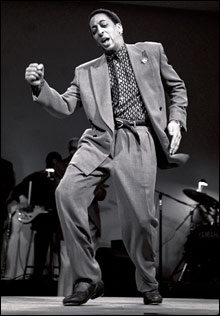
MAGIC FEAT: In relating her experiences with tap stars like Gregory Hines, Goldberg herself becomes a compelling character. |
The frontispiece of Shoot Me While I'm Happy reproduces a poster for a New York Tap Fringe Festival performance in 2005. Jane Goldberg, the self-styled Tap Goddess of the Lower East Side, is pictured as a sketchy figure with a big scribble of hair who promises to "Belly Tap for World Peace!" Goldberg, a feisty, funny character and long-time tap crusader, has written a remarkable memoir.When I met Goldberg, in 1972, she was based in Boston and was writing about dance for Boston After Dark, predecessor of the Phoenix. She'd taken modern-dance classes with Radcliffe's Claire Mallardi (just this spring she appeared in a performance celebrating Mallardi's 80th birthday), but Fred Astaire and Ginger Rogers movies had convinced her that tap was the route to ultimate romance and fulfillment. Goldberg connected in Boston with her first serious tap teacher, Stanley Brown, and soon emigrated to New York, where a tap revival was getting up steam.
At the end of the 1960s, a generation of great dancers, mostly African-American and male, started to resurface after decades of what Goldberg later called the Drought. They'd been featured in movies, theaters, and clubs, but their careers had gone into eclipse when tastes in entertainment changed. Now, banded together as the Hoofers and the Copasetics, they were doing shows again. Critics had become less finicky about distinctions between high art and popular culture, and suddenly these old guys were reclaiming the limelight.

As soon as she hit the Lower East Side, Goldberg started tracking down the master tappers, getting them to teach her their steps and tell their stories. Eventually, she knew them all, from the most famous — Honi Coles, Gregory Hines — to unsung role models Chuck Green and Sandman Sims and lesser-known individualists like Leon Collins and Jimmy Slyde. She put together an act with Charles "Cookie" Cook and they toured for six years as an improbable duo: the 60ish, caustic tap-comic Cook and the Jewish bohemian Goldberg, trading jazz riffs and insults, surrounded by an assortment of guest dancers, musicians, and friends.
Later, or maybe along the way, Goldberg developed a persona as a talking tapper and did solo shows. She also organized the Sole Sisters, a showcase of veterans like Frances Nealy and Dianne Walker and younger women like Brenda Bufalino doing old routines and inventive contributions to the tap renaissance.
| Shoot Me While I’m Happy: Memories from the Tap Goddess of the Lower East Side | By Jane Goldberg | Woodshed Productions | 324 Pages | $25 |
Goldberg recounts these adventures and a lot more in
Shoot Me While I'm Happy. She doesn't boast about her writing career or her flair for the wacky rubric, but the book reveals how good she is at verbal performance. Over the years, she's written important articles on her mentors and the history of tap, but this book is more informal. She seems to be chatting with you, reminiscing, dropping names. But in fact she's creating a literary character and projecting her own quirky humor and anxieties with practiced self-depreciation.
She relates her triumphs — getting to dance with icons — with modest matter-of-factness. She plays down her ingenuity and daring as a promoter. And she describes her misjudgments in excruciating detail, like trying to bring the message of tap to feminists in deepest India or senior citizens hunkered down in Florida.
Tap has produced a new generation now. Most of the hoofers are gone. Those young devotees who paid them for classes and brought them to a new public are still dancing and producing. Tap shows have become a beloved institution, exuberant, inclusive, and headlined by hip-hoppers and hot young virtuosos like Savion Glover. In this loving, lovable book, Jane Goldberg tells us how tap culture regrouped and got over the Drought.